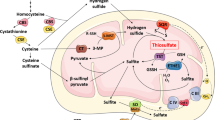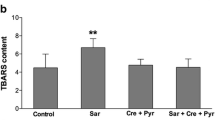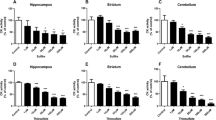Abstract
D-2-Hydroxyglutaric aciduria (DHGA) is a neurometabolic disorder biochemically characterized by tissue accumulation and excretion of high amounts of D-2-hydroxyglutaric acid (DGA). Although the affected patients have predominantly severe neurological findings, the underlying mechanisms of brain injury are virtually unknown. In previous studies we have demonstrated that DGA, at concentrations as low as 0.25 mM, significantly decreased creatine kinase activity and other parameters of energy metabolism in cerebral cortex of young rats. In the present study, we investigated the effect of DGA (0.25-5 mM) on total creatine kinase (tCK) activity, as well as on CK activity in cytosolic (Cy-CK) and mitochondrial (Mi-CK) preparations from cerebellum of 30-day-old Wistar rats in order to test whether the inhibitory effect of DGA on CK was tissue specific. We verified that tCK (22% inhibition) and Mi-CK (40% inhibition) activities were moderately inhibited by DGA at concentrations of 2.5 mM and higher, in contrast to Cy-CK, which was not affected by the acid. Kinetic studies revealed that the inhibitory effect of DGA was non-competitive in relation to phosphocreatine. We also observed that this inhibition was fully prevented by preincubation of the homogenates with reduced glutathione, suggesting that the inhibition of CK activity by DGA is possibly mediated by modification of essential thiol groups of the enzyme. Our present results therefore demonstrate a relatively weak inhibitory effect of DGA on cerebellum Mi-CK activity, as compared to that provoked in cerebral cortex, and may possibly be related to the neuropathology of DHGA, characterized by cerebral cortex abnormalities.
Similar content being viewed by others
REFERENCES
Chalmers, R. A., Lawson, A. M., Watts, R. W. E., Tavill, A. S., Kamerling, J. P., Hey E., and Ogilvie, D. 1980. D-2-Hydroxyglutaric aciduria: Case report and biochemical studies. J. Inherit. Metab. Dis. 3:11-15.
van der Knaap, M. S., Jakobs, C., Hoffman, G. F., Duran, M., Muntau, A. C., Schweitzer, S., Kelley, R. I., Parrot-Rouland, F., Amiel, J., De Lonlay, P., Rabier, D., and Eeg-Olofsson, O. 1999. D-2-Hydroxyglutaric aciduria: Further clinical delineation. J. Inherit. Metab. Dis. 22:404-413.
van der Knaap, M. S., Jakobs, C., Hoffmann, G. F., Nyhan, W. L., Renier, W. O., Smeitink, J. A. M., Catsman-Berrevoets, C. E., Hjalmarson, O., Vallance, H., Sugita, K., Bowe, C. M., Herrin, J. T., Craigen, W. J., Buist, N. R. M., Brookfield, D. S. K., and Chalmers, R. A. 1999. D-2-Hydroxyglutaric aciduria: biochemical marker or clinical disease entity? Ann. Neurol. 45:111-119.
Wajner, M., Vargas, C. R., Funayama, C., Fernández, A., El as, M. L., Goodman, S. I., Jakobs, C., and van der Knapp, M. S. 2002. D-2-Hydroxyglutaric aciduria in a patient with a severe clinical phenotype and unusual MRI findings. J. Inherit. Metab. Dis. 25:28-34.
Gibson, K. M., Craigen, W., Herman, G. E., and Jakobs, C. 1993. D-2-Hydroxyglutaric aciduria in a newborn with neurological abnormalities: A new neurometabolic disorder? J. Inherit. Metab. Dis. 16:497-500.
Silva, C. G., Ribeiro, C. A. J., Leipnitz, G., Dutra-Filho, C. S., Wyse, A. T. S., Wannmacher, C. M. D., Sarkis, J. J. F., Jakobs, C., and Wajner, M. 2002. Inhibition of cytochrome c oxidase activity in rat cerebral cortex and human skeletal muscle by D-2-hydroxyglutaric acid in vitro. Biochim. Biophys. Acta 1586:81-91.
Wallimann, T., Wyss, M., Brdiczka, D., and Nicolay, K. 1992. Intracellular compartmentation, structure and function of creatine kinase isoenzymes in tissues with high and fluctuating energy demands: The ‘phosphocreatine circuit’ for cellular energy homeostasis. Biochem. J. 281:21-40.
Wyss, M., Smeitink, J., Wevers, R. A., and Wallimann, T. 1992. Mitochondrial creatine kinase: A key enzyme of aerobic energy metabolism. Biochim. Biophys. Acta 1102:119-166.
Schlegel, J., Zurbriggen, B., Wegmann, G., Wyss, M., Eppenberger, H., and Wallimann, T. 1988. Native mitochondrial creatine kinase forms octameric structures. I. Isolation of two interconvertible mitochondrial creatine kinase forms, dimeric and octameric mitochondrial creatine kinase: Characterization, localization and structure-function relationships. J. Biol. Chem. 262:16942-16993.
O'Gorman, E., Beutner, G., Wallimann, T., and Brdiczka, D. 1996. Differential effects of creatine depletion on the regulation of enzyme activities and on creatine-stimulated mitochondrial respiration in skeletal muscle. Biochim. Biophys. Acta 1276:161-170.
Saks, V. A., Kuznetsov, A. V., Kuprianov, V. V., Miceli, M. V., and Jacobus, W. E. 1985. Creatine kinase of rat heart mitochondria: The demonstration of functional coupling to oxidative phosphorylation in an inner membrane-matrix preparation. J. Biol. Chem. 260:7757-7764.
Hemmer, W. and Wallimann, T. 1993. Functional aspects of creatine kinase in brain. Dev. Neurosci. 15:249-260.
Burbaeva, G. S., Aksenova, M. V., and Makarenko, I. G. 1992. Decreased level of creatine kinase BB in the frontal cortex of Alzheimer patients. Dementia 3:91-94.
Aksenov, M. I., Aksenova, M. V., Payne, R. M., Smith, C. D., Markesbery, W. R., and Carney, J. M. 1997. The expression of creatine kinase isoenzymes in neocortex of pacients with neurodegenerative disorders: Alzheimer's and Pick's disease. Exp. Neurol. 146:458-465.
Wyss, M. and Shulze, A. 2002. Health implications of creatine: Can oral creatine supplementation protect against neurological and atherosclerotic disease? Neuroscience 112:243-260.
Silva, C. G., Bueno, A. R. F., Schuck, P. F., Leipnitz, G., Ribeiro, C. J. A., Rosa, R. B., Dutra Filho, C. S., Wyse, A. T. S., Wannmacher, C. M. D., and Wajner, M. in press 2003. Inhibition of creatine kinase activity from rat cerebral cortex by D-2-hydroxyglutaric acid in vitro. Neurochem. Int.
Ramirez, O. and Jiménez, E. 2000. Opposite transitions of chick brain catalytically active cytosolic creatine kinase isoenzymes during development. Int. J. Dev. Neurosci. 18:815-823.
Jones, D. H. and Matus, A. I. 1974. Isolation of plasma synaptic membrane from brain by combination flotation-sedimentation density gradient centrifugation. Biochim. Biophys. Acta 356:276-287.
Tsakiris, S. and Deliconstantinos, G. 1984. Influence of phosphatidylserine on (Na+,K+)-stimulated ATPase and acetyl-cholinesterase activities of dog brain synaptossomal plasma membranes. J. Biochem. 22:301-307.
Hughes, B. P. 1962. A method for estimation of serum creatine kinase and its use in comparing creatine kinase and aldolase activity in normal and pathological sera. Clin. Chim. Acta 7:597-604.
Lowry, O. H., Rosebrough, N. J., Farr, A. L., and Randall, R. J. 1951. Protein measurement with the Folin phenol reagent. J. Biol. Chem. 193:265-267.
Cornish-Bowden, A. 1974. A simple graphical method for determining the inhibition constants of mixed, uncompetitive and non-competitive inhibitors. Biochem. J. 137:143-144.
Dixon, M. and Webb, E. C. 1964. Enzymes. 2nd ed. London, Longman.
Oliver, C. N., Starke-Reed, P. E., Stadtman, R., Liu, G. J., Carney, J. M., and Fliyd, R. A. 1990. Oxidative damage to brain proteins, loss of glutamine synthetase activity, and production of free radicals during ischemia/reperfusion injury to gerbil brain. Proc. Natl. Acad. Sci. 87:5144-5147.
Burmistrov, S. O., Mashek, O. P., and Kotin, A. M. 1992. The action of acute alcoholic intoxication on the antioxidant system and creatine kinase activity in the brain of rat embryos. Eksp. Klin. Farmakol. 55:54-56.
Stanimirovic, D. B., Wong, J., Ball, R., and Durkin, J. P. 1995. Free radical-induced endothelial membrane dysfunction at the site of blood-brain barrier: Relationship between lipid peroxidation, Na, K-ATPase activity, and 51Cr release. Neurochem. Res. 20:1417-1427.
Avrova, N. F., Victorov, I. V., Tyurin, V. A., Zakharova, I. O., Sokolova, T. V., Andreeva, N. A., Stelmaschuk, E. V., Tyurina, Y. Y., and Gonchar, V. S. 1998. Inhibition of glutamate-induced intensification of free radical reactions by gangliosides: Possible role in their protective effect in rat cerebellar granule cells and brain synaptosomes. Neurochem. Res. 23:945-952.
Kölker, S., Okun, J. G., Ahlemeyer, B., Wyse, A. T. S., Hörster, F., Wajner, M., Kohlmüller, D., Mayatepek, E., Krieglstein, J., and Hoffmann, G. 2002. Chronic treatment with glutaric acid induces partial tolerance to excitotoxicity in neuronal cultures from chick embryo telencephalons. J. Neurosci. Res. 68:424-431
Kölker, S., Pawlak, V., Ahlemeyer, B., Okun, J. G., Hörster, F., Mayatepek, E., Krieglstein, J., Hoffman, G. F., and Köhr, G. 2002. NMDA receptor activation and respiratory chain complex V inhibition contribute to neurodegeneration in D-2-hydroxyglutaric aciduria. Eur. J. Neurosci. 16:21-28.
Hamman, B. L., Bittl, J. A., Jacobus, W. E., Aleen, P. D., Spencer, R. S., Tina, R., and Ingwall, J. S. 1995. Inhibition of creatine kinase reaction decreases the contractile reserve of isolated rat hearts. Am. J. Physiol. 269:H1030-H1036.
Gross, W. L., Bak, M. I., Ingwall, J. S., Arstal, I. M. A., Smith, T. W., Balligand, J. L., and Kelly, R. 1996. Nitric oxide inhibits creatine kinase and regulates rat heart contractile reserve. Proc. Natl. Acad. Sci. USA 93:5604-5609.
Holzman, D., Meyers, R., Khait, I., and Jensen, F. 1997. Brain creatine kinase reaction rates and reactant concentrations during seizures in developing rats. Epilepsy Res. 27:7-11.
Hyakudo, T., Hori, H., Tanaka, I., and Igisu, H. 2001. Inhibition of cretine kinase activity in rat brain by methyl bromide gas. Inhal. Toxicol. 13:659-669.
Matsuoka, M., Inoue, N., and Igisu, H. 1992. Effects of methylmercury chloride on creatine kinase activity in the rat brain. J. UOEH 14:77-81.
Kaldis, P., Hemmer, W., Zanolla, E., Holtzman, D., and Wallimann, T. 1996. 'Hot spots' of creatine kinase localization in brain: Cerebellum, hippocampus and choroid plexus. Dev. Neurosci. 18:542-554.
Ilyin, S. E., Sonti, G., Molloy, G., and Plata-Salaman, C. R. 1996. Creatine kinase-B mRNA levels in brain regions from male and female rats. Brain Res. Mol. Brain Res. 41:50-56.
Hemmer, W., Zanolla, E., Furter-Graves, E. M., Eppenberger, H. M., and Wallimann, T. 1994. Creatine kinase isoenzymes in chicken cerebellum: Specific localization of brain-type creatine kinase in Bergmann glial cells and muscle-type creatine kinase in Purkinje neurons. Eur. J. Neurosci. 6:538-549.
Eeg-Olofsson, O. 2000. D-2-Hydroxyglutaric aciduria with cerebral, vascular and muscular abnormalities in a 14-year-old-boy. J. Child. Neurol. 15:488-492.
Quest, A. F. G., Eppenberger, H. M., and Wallimann, T. 1990. Two different B-type creatine kinase subunits dimerize in a tissue-specific manner. FEBS Lett. 2:299-304.
Kenyon, G. L. and Reed, G. H. 1983. Creatine kinase: Structure-activity relationships. Adv. Enzymol. 54:367-426.
Furter, R., Furter-Graves, E. M., and Wallimann, T. 1993. Creatine kinase: The reactive cysteine is required for synergism but is nonessential for catalysis. Biochemistry 32:7022-7029
Zhou, G., Somasyndaram, T., Blanc, E., Parthasarathy, G., Ellingtin, W. R., and Chapman, M. S. 1998. Transition state structure of arginine kinase: Implications for catalysis of bimolecular reactions. Proc. Natl. Acad. Sci. USA 95:8449-8454.
Brown, C. S. and Cunningham, L. W. 1970. Reaction of reactive sulfhydryl groups of creatine kinase with dansyl chloride. Biochemistry 9:3878-3885.
Reddy, S. R. and Watts, D. C. 1979. Inhibition of creatine kinase by iodoalkanes: Further appraisal of the essential nature of the reactive thiol group. Biochim. Biophys. Acta 569:109-113.
Hou, L. W. and Vollmer, S. 1994. The activity of S-thiomethyl modified creatine kinase is due to the regeneration of free thiol at the active site. Biochim. Biophys. Acta 1205:83-88.
Wolosker, H., Panizzutti, R., and Englender, S. 1996. Inhibition of creatine kinase by S-nitrosoglutathione. FEBS Lett. 392:274-276.
Mekhfi, H., Veksler, V., Mateo, P., Maupoil, V., Rochette, L., and Ventura-Clapier, R. 1996. Creatine kinase is the main target of reactive oxygen species in cardiac myofibrils. Circ. Res. 78:1016-1027.
Stachowiak, O., Dolder, M., Wallimann, T., and Richter, C. 1998. Mitochondrial creatine kinase is a prime target of peroxynitrite-induced modification and inactivation. J. Biol. Chem. 273:16694-16699.
Nathan, C. and Xie, Q. W. 1994. Nitric oxide synthases: Roles, tools, and controls. Cell 78:915-918.
Yuan, G., Kaneko, M., Masuda, H., Hon, R. B., Kobayashi, A., and Yamazaki, N. 1992. Decrease in heart mitochondrial creatine kinase activity due to oxygen free radicals. Biochim. Biophys. Acta 1140:78-84
Meister, A. and Anderson, M. E. 1983. Glutathione. Annu. Rev. Biochem. 52:711-760.
Halliwell, B. and Gutteridge, J. M. C. 1990. Role of free radicals and catalytic metal ions in human disease. Methods Enzymol. 186:1-85.
Powers, S. K. and Hamilton, K. 1999. Anti-oxidants and exercise. Clin. Sports Med. 18:525-536
Jane, A., Roskams, I., and Connor, J. R. 1994. Iron, transferrin and ferritin in rat brain during development and aging. J. Neurochem. 63:709-716.
Lipskaya, T. Yu. 2001. Mitochondrial creatine kinase: Properties and function. Biochemistry (Mosc.). 66:1361-1376.
Soboll, S., Brdiczka, D., Jahnke, D., Schmidt, A., Schlattner, U., Wendt, S., Wyss, M., and Wallimann, T. 1999. Octamer-dimer transitions of mitochondrial creatine kinase in hear disease. J. Mol. Cell Cardiol. 31:857-866.
Khuchua, Z. A., Qin, W., Boero, J., Cheng, J., Payne, R. M., Saks, V. A., and Strauss, A. W. 1998. Octamer formation and coupling of cardiac sarcomeric mitochondrial creatine kinase are mediated by charged N-terminal residues. J. Biol. Chem. 273:22990-22996.
Halliwell, B. 1996. Free radicals, protein and DNA: Oxidative damage versus redox regulation. Biochem. Soc. Trans. 24:1023-1027
Hoffman, G. F., Meier-Augenstein, W., Stocker, S., Surtees, R., Rating, D., and Nyhan, W. L. 1993. Physiology and pathophysiology of organic acids in cerebrospinal fluid. J. Inherit. Metab. Dis. 16:648-669.
Korosheltz, W. J., Jenkins, B. G., Rosen, B. R., and Beal, M. F. 1997. Energy metabolism defects in Huntington's disease and effects of coenzyme Q10. Ann. Neurol. 41:120-130.
Shults, C. W., Beal, M. F., Fontaine, D., Nakano, K., and Haas, R. H. 1998. Absorption, tolerability, and effects of mitochondrial activity of oral coenzyme Q10 in parkisonian patients. Neurology 50:793-795.
Author information
Authors and Affiliations
Corresponding author
Rights and permissions
About this article
Cite this article
da Silva, C.G., Bueno, A.R.F., Rosa, R.B. et al. Inhibition of Mitochondrial Creatine Kinase Activity by D-2-Hydroxyglutaric Acid in Cerebellum of Young Rats. Neurochem Res 28, 1329–1337 (2003). https://doi.org/10.1023/A:1024936129908
Issue Date:
DOI: https://doi.org/10.1023/A:1024936129908




